
City Greenery: Sustaining Urban Development and Tree Preservation in Toledo
Toledo’s leaders understand that applying a sustainability lens to revitalization efforts can make all the difference.
But the city flies largely under the radar, the object of Rust Belt self-loathing. Its neighborhoods wracked with drug addiction and mental illness bleed together with the blight of shuttered malls. Nevertheless, hope persists.
1. Enhances Quality of Life
2. Improves Air Quality
Toledo’s neighborhoods are in a period of revitalization and renewal. The city’s community-driven planning framework is bringing the power of sustainability to these areas.
Urban reforestation will improve air quality, reduce stormwater runoff, create a cooler environment and help mitigate urban heat islands. It will also provide wildlife habitat and sequester carbon to counter climate change.
Local activists Nic Botek, Colleen Eldridge and Monika Perry are bringing the future of sustainability to Toledo through the Toledo Permaculture Network. Their efforts include building food forests in abandoned vacant lots and hosting workshops on sustainable living and alternative energy production.
3. Increases Property Values
Real estate investors are often influenced by the value of a community, particularly its attractiveness and growth potential. When businesses are thriving, property values increase and attract new investment opportunities.
For instance, a local business owner invested in the Junction neighborhood to redevelop contaminated properties as agricultural and green energy industries. This helped revitalize the area and attract new residents.
Similarly, East Toledo residents benefit from the City’s reforestation program. For example, trees help reduce the need for mowing and provide shade and curb appeal. Additionally, the use of flexible materials like Flexi-Pave near tree bases can save money and protect trees.
4. Enhances Health and Well-Being
Researchers found that people with access to green spaces have lower rates of depression and more positive mental health overall. Trees also make cities more visually appealing and relaxing, which can improve moods and reduce stress levels.
The City of Toledo’s community garden water program helps residents affordably install gardens and provides the resources to grow healthy food. In addition, Toledo Edison’s active vegetation management program keeps incompatible trees and shrubs away from their power lines.
In East Toledo, where many struggle with addiction and mental health issues, Pastor Kenneth Dantzler says a canopy of trees brings hope to his neighborhood. Nonprofit urban planning groups like the Toledo Design Collective bring holistic approaches to revitalizing neighborhoods alongside the people who live there.
5. Enhances Economic Development
With a resurgence of plants, trees and wildlife there is a renewed sense of nature within the city. It brings people together in a natural environment and unites them with the living world around them.
It helps revitalize the community and creates jobs, he said. In addition, the planting of trees will help reduce flooding and property damage in the city.
Providing water hook-ups to community gardens can ease some of the financial burden associated with the creation and upkeep of garden space, he said. It also helps to encourage more residents to participate in gardening, which can benefit their mental and physical health.
6. Enhances Community Cohesiveness
Whether it’s improving neighborhoods with new green spaces or supporting community gardening, City Greenery brings hope and opportunity to Toledo. The hope comes in the form of jobs, improved health and a stronger identity for communities.
The opportunity comes in the form of revitalizing businesses, new parks and recreation, and a more vibrant, beautiful city. The greenery also offers community residents a chance to escape from the hustle and bustle of everyday life.
For example, the City of Toledo’s community garden water program offers a cost share for residents to hook up their gardens to city water. This helps reduce barriers to creating and maintaining community gardens, which offer an affordable source of healthy food while improving mental health and reducing stress.
7. Enhances Safety
Mary Wilson, who lives in the Junction neighborhood, said young kids there need a safe place to play. She’s a fan of the neighborhood beautification effort, but wants to know what crime prevention efforts are in place.
Toledo has a long history of Rust Belt decline and has been dealing with environmental challenges like recurrent flooding and water quality issues. Learn how the city explored green infrastructure to help address these challenges with this case study. The city first learned about green infrastructure through a feasibility study and then developed a pilot project to gain community buy-in.